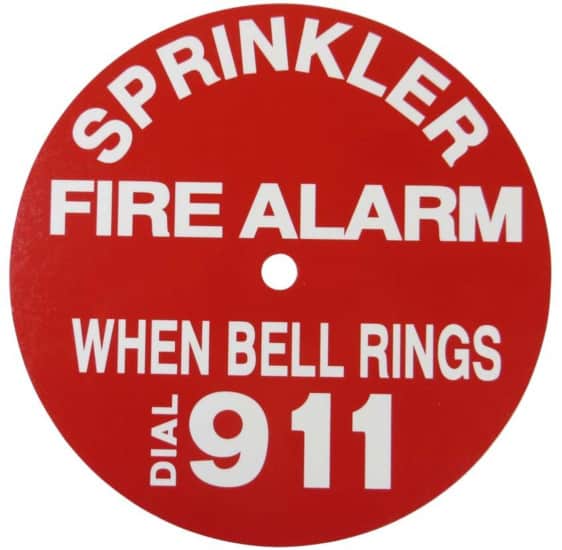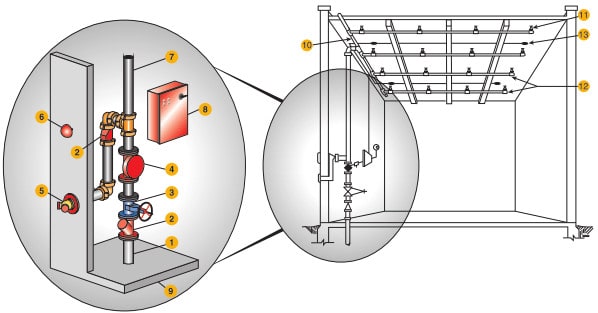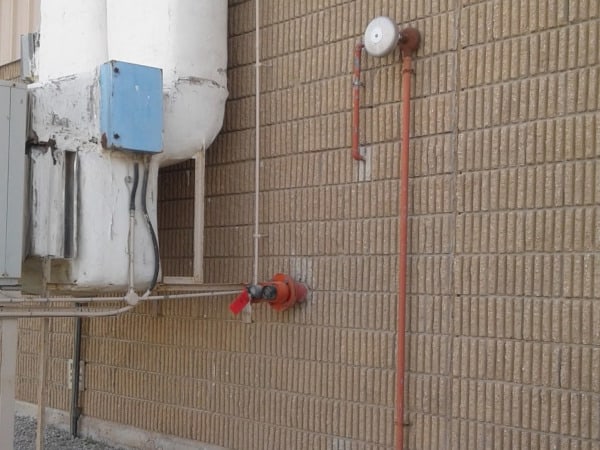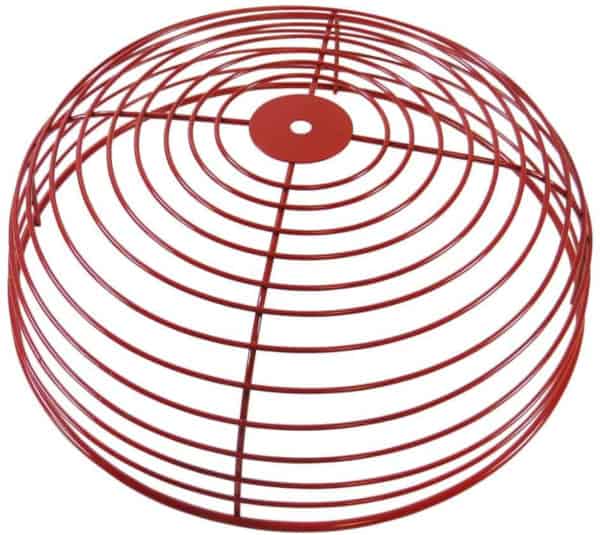Two fire bell types—typically located outdoors—connect to fire risers, encouraging prompt evacuation and emergency response
Fire risers, both in fire sprinkler and standpipe systems, contain or connect to dense collections of essential fire protection components, including alarm-sounding devices like water motor gongs and fire bells. Because these risers join permanent water sources to the rest of the fire protection system, they’re an ideal location for backflow-preventing (check) valves, drain valves, control valves, and other equipment needed for proper operation and periodic maintenance.
But how do fire alarm bells (and water motor gongs) work with fire risers? In this article, we briefly explain what happens at the riser when water flows through a fire sprinkler or standpipe system. We then talk about different ways fire risers and fire alarm bells work together in both commercial and residential fire sprinkler systems, as well as standpipe systems.
Note that throughout this piece, we rely on four standards from the National Fire Protection Association (NFPA), which provide installers with guidelines for the selection and placement of fire alarm bells connected to system risers:
- Commercial sprinkler systems—NFPA 13: Standard for the Installation of Sprinkler Systems
- Systems for multi-family residential buildings—NFPA 13R: Standard for the Installation of Sprinkler Systems in Low-Rise Residential Occupancies
- Home sprinkler systems—NFPA 13D: Standard for the Installation of Sprinkler Systems in One- and Two-Family Dwellings and Manufactured Homes
- Standpipe systems—NFPA 14: Standard for the Installation of Standpipe and Hose Systems
If you’ve found this article while looking for fire protection components, you can shop our selection of:
- 10″, 120-volt fire bells—often used when installing a waterflow alarm that doesn’t connect to a fire alarm control panel
- 10″, 24-volt fire bells listed and designed for use with many fire alarm systems
- Water motor gongs that sound a sprinkler or standpipe alarm without electricity
- Back boxes and wire guards that meet NFPA 13 requirements regarding protection for outdoor bells
- Our full line of fire bells and accessories
Fire alarm bells installed at the system riser can detect changes in flow or pressure throughout the entire system
When a fire alarm bell rings, help is on the way—or is it? The answer: not always. In fact, some ringing bells may simply provide a building’s staff, occupants, or passersby with their first indication that something’s gone awry. For example, some bells may feature signs that read “Sprinkler fire alarm: when bell rings, dial 911.” They’re there for a reason: help may or may not be on the way.

A ringing outdoor bell indicates that water has started to flow through a fire sprinkler or standpipe system. This design ensures that when a sprinkler head opens, or water sprays from an indoor hose connection, people outdoors will stay clear of the building—and contact the fire department if necessary. Some well-placed fire alarm bells even guide firefighters to essential equipment used to supply water to a fire sprinkler or standpipe system.
But why connect an alarm bell to a fire riser, specifically? Water enters a fire sprinkler or standpipe system through the system riser, a pipe outfitted with essential fire protection components such as:
- A check valve, backflow preventer, or both. These devices help to maintain pressure in the system and stop water from contaminating public water supplies.
- The control valve, which can shut off the flow of water to sprinklers, hoses, or hose connections for inspections, tests, and maintenance work.
- Pressure gauges used to evaluate the integrity of the piping system.
- A drain valve used in testing and repairs.
- Water flow alarms, which (as the name suggests) sound in response to the movement of water through pipes
During a fire, water passes through the system riser from an outside source (such as a fixed tank or municipal supply line) and proceeds to a series of other pipes leading to fire sprinkler heads, permanently mounted hoses, or hose connections. Because the riser is installed at the system’s point of origin, it’s the ideal location to install devices designed to detect changes in flow or pressure throughout the entire system.
Different fire riser configurations allow for the use of an electronic fire alarm bell or a water motor gong
As we explained in the second part of our fire riser series, many wet-pipe sprinkler system risers come in one of two different forms: straight risers and alarm check risers. The difference—which is significant for how the fire risers work with fire alarm bells—comes down to whether the riser uses an alarm check valve.
Alarm check risers feature an alarm valve (or alarm check valve). For the most part, an alarm check valve plays the same role as any other check valve, guaranteeing that:
- Water flows in only one direction (toward the sprinklers or hose connections that need it)
- Pressure in the system is maintained
But alarm valves also feature an alarm port. This port often connects to a container, called a retard chamber, that fills as water enters the system. When there’s no more room left in the retard chamber, water overflows into adjacent pipes and fittings. This overflow may activate an electronic pressure switch—which, in turn, activates an electric fire alarm bell—or a water motor alarm (or gong). Unlike electric bells, a water motor gong relies only on the force of moving water to turn. Watch the video below to see a water motor alarm activate during testing:
Straight risers use a standard check valve instead of an alarm valve. In these system risers, fire alarm bells activate electronically after a physical trigger. Switches installed along the system riser may use a paddle, which moves as water flows, or electronic components designed to detect changes in pressure. When properly configured, the result is the same: activation of the switch triggers a fire alarm bell.
Fire alarm bells joined to commercial fire risers can help satisfy NFPA 13’s requirements for waterflow alarm devices
Commercial fire sprinkler systems with more than 20 sprinklers may use an alarm bell as part of a local waterflow alarm
Every NFPA 13-compliant system riser features a “waterflow alarm device” (section 3.3.215, 2019 edition). These devices, according to the definition provided in section 3.3.226, consist of an attachment that “detects a predetermined water flow” (flow or pressure switches) and that:
- Initiates an alarm condition in a fire alarm system, or
- Initiates a fire pump or local audible or visual alarm
All commercial fire sprinkler systems with more than 20 sprinklers require a “local waterflow alarm” (16.11.2.1). While the term “local” isn’t clearly defined, many installations place the alarm close to the system riser, as in the diagram below.

Item 6 in this deluge fire sprinkler system is a “local waterflow alarm.” Source: NFPA 13 Handbook
According to section 16.11.1, NFPA 13 allows (but does not specifically require) the use of a fire alarm bell with local water-flow alarms. A local water-flow alarm must have either:
- A listed mechanical alarm, horn, or siren, or
- A listed electric gong, bell, speaker, horn, or siren
In a non-binding note to this section, the NFPA notes that audible alarms such as these “are normally located on the outside of the building.” However, outdoor alarm bells may not be needed if the sprinkler system is part of a monitored fire alarm system that uses “listed audible inside alarm devices.” However, the International Building Code (IBC), which many jurisdictions have adopted as their fire code, explicitly requires these audible devices to be located on the building’s exterior.
For more on placement requirements, check out “Where Does an External Sprinkler Alarm Bell Need to Be Mounted in Relation to a Fire Department Connection?”
While a water motor gong will work as a fire alarm bell, the two devices aren’t totally interchangeable
Either a water motor gong or an electric fire alarm bell may be used as part of a local waterflow alarm in any of the major fire sprinkler system types. Wet-pipe sprinkler systems will need an alarm check valve. Dry-pipe, deluge, and preaction systems may each be configured to use a water motor gong (with a dry-pipe, deluge, or preaction valve, respectively).
Nevertheless, a preaction or deluge system using a water motor gong will also require an electronic notification device.
From the 2019 edition of NFPA 13
16.11.3.3 Preaction and Deluge Systems. The alarm apparatus for deluge and preaction systems shall consist of alarms actuated independently by the detection system and the flow of water.
Single-interlock and double-interlock preaction systems are specifically designed to wait until smoke, heat, or other sensors activate before water can be released into the system. Pipes in deluge systems won’t fill until an initiating device sends a signal to a deluge valve (through a monitoring panel).
What this means that there’s no arrangement of a water motor gong that can act as an alarm “actuated… by the detection system.” On the other hand, a water motor gong or an electronic fire alarm bell and waterflow switch may meet the section’s requirement for an alarm actuated by “the flow of water.”
There may be other limits to the use of water motor-operated devices. In a non-binding note to section 16.11.8, NFPA 13 cautions that:
- The length of pipe to a mechanically operated device should be no longer than 75 feet
- The device should not be placed more than 20 feet “above the alarm device or dry pipe valve”
Further, only certain types of pipes may be used.
From the 2019 edition of NFPA 13:
16.11.1.3 All piping to water motor-operated devices shall be galvanized steel, brass, copper, or other approved metallic corrosion-resistant material of not less than 3/4 in. (20 mm) nominal pipe size.

To sum up briefly:
- Electric and mechanical fire alarm bells may be used with wet, dry, preaction, and deluge systems
- However, water motor gongs alone can’t meet preaction and deluge systems’ requirements for alarms actuated “by the detection system” (electronic sensors)—these require separate alarms
- Water motor gongs aren’t recommended if more than 75 feet of piping is required to join the alarm to the alarm valve, dry valve, preaction valve, or deluge valve
Residential fire sprinkler systems and standpipe systems have simpler requirements for fire alarm bells at fire risers
Local waterflow alarms are essential in NFPA 13R systems and simply nice-to-have in NFPA 13D systems
Large residential fire sprinkler systems designed in accordance with NFPA 13R must have a local waterflow alarm (6.16.1, 2016 edition). All local waterflow alarms must be connected to the fire alarm system when the building has one (6.16.2).
Like NFPA 13 systems, NFPA 13R systems may use either a water motor gong or an electric fire alarm bell with these local waterflow alarms—with the caveat that an NFPA 13R system will need a water motor gong and an electronic flow switch if the building has a fire alarm system. Otherwise, these alarms are installed in accordance with NFPA 13 (6.16.3).

In family homes and other residences with NFPA 13D-compliant systems, local waterflow alarms are only required when the home does not have smoke detectors installed in accordance with NFPA 72: National Fire Alarm Code (7.6, 2016 edition). However, homeowners would still be wise to install a local waterflow alarm even when it’s not required.
The NFPA 13D and NFPA 13R Handbook notes that waterflow alarms can alert homeowners or occupants to a broken pipe or other non-fire activation of the sprinkler system, preventing or mitigating costly water damage incidents.
NFPA 13D doesn’t require installers to place notification devices outdoors. However, each device “is intended to be a single alarm audible from the outside of the building” (A.7.6).
Fire alarm bells may be found with most standpipe system types
NFPA 14 standpipe systems provide firefighters with what basically amount to indoor fire hydrants and, in some cases, they have permanently installed indoor hoses for use by a building’s occupants. Nearly every standpipe system needs a waterflow alarm device, save for manual-dry standpipes, which have no permanent water source (5.6.1). As with fire sprinkler systems, the audible alarms for standpipe systems are usually, but not always, placed on the outside of the building (A.5.6).
Building and system design have a substantial impact on installers’ choices for alarm bells at fire risers
Fire alarm bells play an important role in letting a building’s occupants and neighbors know that something’s amiss. For preventing water damage and minimizing fire hazards, water-flow alarms at the system riser are irreplaceable—particularly in structures without a monitored fire alarm system.
Fire alarm bells have received careful attention in several volumes of NFPA codes and standards. QRFS invites readers to explore related topics such as:
We invite you to check out our selection of fire protection equipment, including a line of electric fire alarm bells. With sizes ranging from 6” to 10” and DC or AC power sources available, these UL-listed bells are ideal for fire protection service. For those installing new riser assemblies, take a look at our:
As a final note: outdoor fire alarm bells are subject to damage from water, dirt, debris, and other wear. Protect them with bell wire guards—which shield the gong against light impact and nesting birds—and air-tight back boxes made to protect sensitive electrical components.

Browse our selection of fire alarm bells and accessories.
Questions? Call us at +1 (888) 361-6662 or email support@qrfs.com.
This blog was originally posted at blog.qrfs.com. If this article helped you, check us out at Facebook.com/QuickResponseFireSupply or on Twitter @QuickResponseFS.




My house was built 9 years ago, equipped with fire sprinklers throughout. Outside of the house, there is a Sprinkler Fire Alarm Bell. Only recently, I noticed that this bell gives out a “single beeping” sound every 15 minutes. What does it signify? Is this a concern? I appreciate any troubleshooting response. Thanks.
Vince — Generally speaking, fire sprinkler alarm bells are designed to go off (pretty loudly) when water is flowing because the sprinklers are activated. What you describe almost sounds like a maintenance status signal for a fire alarm system. You should contact a local fire protection contractor to determine what this equipment is and why it is sounding continually.